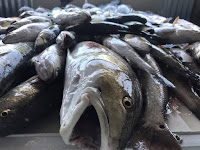Anglers! It’s June! Summer has arrived. It’s time to begin the migration towards the outer bays and lakes. Like the predator fish, we will be following our prey to their Summer habitats. As you know, speckled trout move out to the deeper water bays, lakes, and sounds in huge numbers to spawn and feed. Along the northern gulf, many of these areas are littered with shallow water gas rigs, reefs, and islands. We fish these areas because we know the fish we are chasing love to hold onto structure for protection and ambush points. Many times when we are having windy springs the fish tend to hold onto the islands and reefs because they can be somewhat protected. Plus, they can have good salinity for spawning. It’s like the old saying “right place, right time!” You have probably heard 90% of the fish are caught by 10% of the fisherman. The reason why this holds true is that the anglers who catch the most fish know where the fish will be located under the conditions nature has offered over the past month. The migration of shrimp from the inside to outside areas is the reason the fish move outside too. The speed of this migration can be altered by factors such as salinity, winds, temperature and bait movement. If you understand each factor, you will find the fish!
Salinity
As Spring begins, storms from cool fronts will pass, giving the gulf some heavy rain. Also, up north many of the main rivers are beginning to swell due to melting snow. Both of these contribute to lower salinities due to freshwater run off, which in turn will move fish towards higher salinity areas. We have this issue in Hopedale, LA where my charter service is based. The freshwater inundates the outer bays and lakes, drops the salinity, and drastically moves fish east. This can happen from larger creeks and rivers lining the entire gulf coast. When this happens, research what areas are not affected by this run off and begin your migration there. Speckled trout will not spawn in areas of low salinity because their eggs must have moderate salinity to survive.
Winds
Windy springs are becoming the norm in May and June. Years ago, May was the month that the winds laid down and anglers would venture outside in hopes of huge speckled trout schools. Now June is when we make moves because May is windier. This pattern will confine us to smaller areas to hide from the wind in search of predator fish. Let the wind be your friend! Use the wind to fish the windward banks with moving water. I find that the windy banks offer the predator fish good hiding spots to ambush, because in the somewhat stained water, prey cannot see them cruising the banks. The winds are normally out of the south, which will push water towards the interior marshes, providing a better incoming tide. Remember incoming tides will locate predator fish tight to structure so they can ambush prey.
Temperature
Water temperatures will begin to warm above 80 degrees, prime for predator activity. As water temps rise, fish metabolism will increase proportionally. This not only means that the fish will become very active and feed more often, but also they will gather in schools, looking for larger schools of prey. I really love the warm June water because I can actually see the pattern changing from scattered fish to schooling fish. Also remember if you are fishing oyster beds or reefs the water temperatures will increase faster due to the rocks ability to hold the heat longer in a 24-hour period. I will find oysters during the beginning of June because I know that the fish around shells or rock jetties will be more active and in tighter schools than fish that are not around rocks.
Bait Movement
Lastly, bait movement is crucial for you finding feeding fish jumping into your ice chest. If you are fishing in June but don’t see any bait movement, you need to keep moving. I frequently encounter areas void of baitfish all together. This could happen overnight due to tide changes, winds or salinity changes. I normally look for signals of feeding fish such as birds diving, mullet fleeing or shrimp boats in the area. These signs will tell you if there is prey around for the predators to feed. Many times I will see fish crashing through schools of mullet on the surface, letting me know that there are apex predators and their prey are in the area. I love to use baits such as the She Dog by MirrOlure or a Browns Fat Boy to locate the fish. These baits cover a lot of ground in a short period of time allowing you the angler to not waste time anchoring on spots that may not hold good numbers of fish. The northern gulf is known for anglers using live bait under popping corks! We all love to use this presentation because it is very productive. I have been using the new VersaMaxx Bolt wired popping cork and this thing really works! The cork is the ONLY wired cork that gives anglers the ability to adjust leader length without cuts and knot tying. Practical and time saving. These corks allow me to have my customers fishing shallow near an island during the early morning, and as the sun rises I can adjust my depth deeper with a few quick wraps of the leader. Not only does this cork increase my customers catch because they are fishing correctly at each different scenario but the “Clacking Sound” made by the cork and stainless steel beads are irresistible to predator fish! You have got to try one. See www.VersaMaxx.com
Follow us on Facebook or check out our website at www.captcharlie.com.
See ya soon!
Capt. Charlie Thomason




Comments
Post a Comment